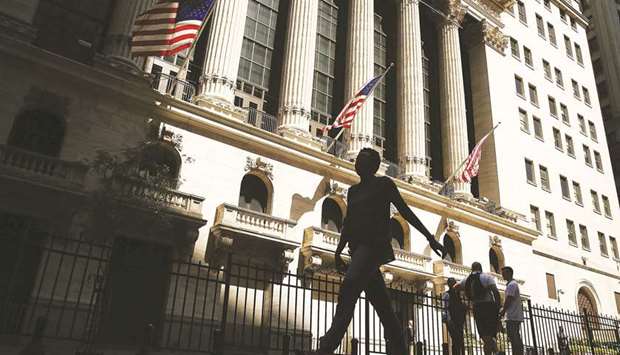Nerves are fraying underneath the stock market’s technology-fuelled rally. Short bets against the biggest equity exchange-traded fund are stubbornly high and recently ticked up, even after the ETF’s 41% climb from March’s lows. The Cboe Volatility Index – known as the market’s “fear gauge” – remains elevated, while investors are piling into products that shield against losses. Meanwhile, a near-record mountain of cash seems stuck on the sidelines. All this as liquidity is in short supply.
While pundits will argue forever whether any of those things are actually bad news for bulls, the stats show caution is bubbling beneath a surge that’s left behind everything but the biggest of tech companies. Heavyweights such as Apple Inc and Amazon.com Inc hitting record highs have helped cushion the S&P 500 from a resurgence in coronavirus cases, with the gauge down about 0.2% over the past month. An equally weighted version of the index – which gives Royal Caribbean Cruises Ltd as much influence as Microsoft Corp – has tumbled roughly 6.4% over that same period.
“It’s been a bull market that really has not been fully embraced,” said Emily Roland, co-chief investment strategist at John Hancock Investment Management. “There’s a certain amount of skepticism inherent in investors today, and it makes sense.”
Stubborn shorts: Scepticism is evident in the still-sizeable cohort of holdouts betting against the $278bn SPDR S&P 500 ETF Trust, ticker SPY. Short interest as a percentage of shares outstanding on SPY – a rough indicator of bearish bets on the fund – is currently 5.1%, according to data from IHS Markit Ltd. Short-interest reached a near-record of 7.4% on March 3, and was as low as 1.2% at the beginning of 2020.
There’s “no doubt” that the Fed’s stimulus is driving the run-up in asset prices, which could explain the unloved nature of the rally, according to Penn Mutual Asset Management.
Volatility jitters: While well below March’s soaring heights, the VIX is still flashing warnings for a stock market fresh off its best quarter since 1998. The measure of implied equity swings remains elevated at about 27, roughly double its February low. The gauge spent all of 2019 below 30.
Rising stocks usually imply a falling VIX, as markets price in good news on the horizon. However, the blistering speed of the equity rebound has upset that relationship, according to Goldman Sachs Group Inc, which estimates that the gap between the gauge and S&P 500 returns is one of the largest on record.
Caution is evident in ETF flows. The $1.2bn ProShares Ultra VIX Short-Term Futures ETF – the largest volatility-tracking fund – posted roughly $263mn in inflows last week for its strongest weekly showing since 2016, and is on track to absorb an additional $159mn this week.
Building a buffer: The current landscape has sparked interest in so-called buffer ETFs, which cushion holders from a certain percentage of losses in exchange for a cap on gains. It’s a space pioneered by niche issuer Innovator ETFs – whose funds have attracted over $3bn since first launching in 2018 – though competitors have started to launch rival defined-outcome ETFs as demand grows.
“For people who have FOMO right now and they’ve been sitting on the sidelines and missed a 40% bounce, they’re saying, ‘do I get in now or are we back at a top?’” said Bruce Bond, Innovator’s chief executive officer. “It allows them to not have to time the market perfectly, but to get in and participate in the upside.”
So far, the buffer funds have worked as advertised. When stocks bottomed on March 23, the $252mn Innovator S&P 500 Power Buffer ETF was nursing year-to-date losses of 17.5% versus the S&P 500’s 30% tumble. Four months later, the Innovator ETF is up about 1.3% in 2020 while the index is still down 1.4%.
Cash hoard: And then there’s the near-record levels of cash sitting on the sidelines. US money-market absorbed $1tn during the pandemic-fueled turmoil, swelling total assets to an all-time high of roughly $4.8tn in late May. That stockpile has started to shrink – barely. The total sum still sits at about $4.65tn, Investment Company Institute data show.
“That money has to come from somewhere, and presumably it’s coming out of risk assets,” said Phil Orlando, chief equity strategist at Federated Hermes. “This extraordinary amount of cash is the one metric you can put your finger on that would suggest you’ve got some concerns.”
Shallow depth: While massive intervention on the part of the Federal Reserve has largely restored bond market functioning, JPMorgan Chase & Co warns that equity liquidity levels are far from normal. Market depth for E-mini S&P 500 futures – the ability to trade without substantially impacting prices – remains about 60% below levels seen before March’s correction, analysts wrote in a note.
That “unstable equilibrium” could leave stocks exposed should turmoil descend on markets again, they wrote.
“Liquidity conditions have improved considerably, though not fully, and overall functioning has mostly been restored, but markets remain in an unstable equilibrium and vulnerable to shocks,” strategists including Joyce Chang, Nikolaos Panigirtzoglou and Marko Kolanovic wrote in a report.

People walk by the New York Stock Exchange. Heavyweights such as Apple and Amazon.com hitting record highs have helped cushion the S&P 500 from a resurgence in coronavirus cases, with the gauge down about 0.2% over the past month.


